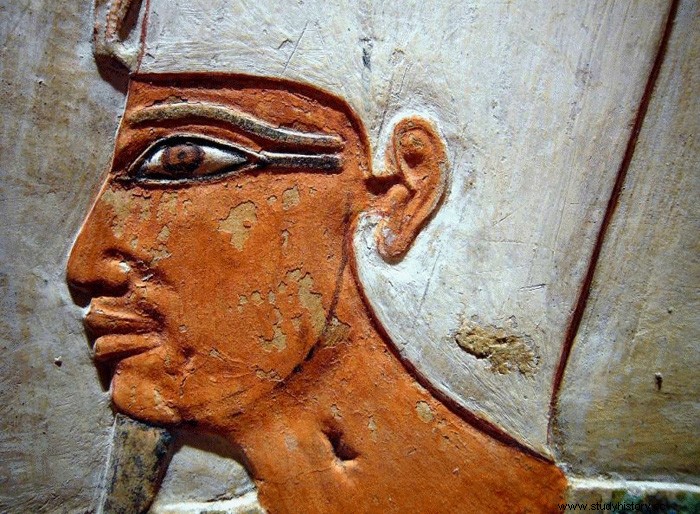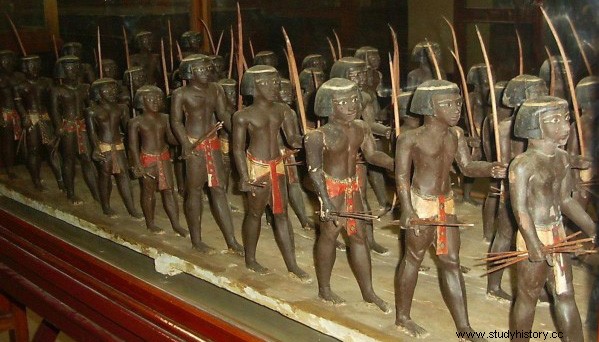
FROM THE VIITH TO THE XTH DYNASTY:
The slow decline of centralized administration during the Old Kingdom, combined with severe droughts between 2200 and 2150 BC. J.-C. causes the entry of the country in a period of 140 years dominated by famine and the Civil War . Egypt is poorly defended and enters a dark period, crossed by lighted sovereigns and foreign invaders. Pharaohs without power are jostling for the throne and succeeding each other at a frantic pace.
Fall of royalty and the centralized state:
The nomarchs (provincial administrators) seize power in their region and cause the fall of royalty and the centralized state. The country is fragmented and enters a great period of confusion. However, as the nomarchs no longer owe the pharaoh tribute and control their own resources, the provinces grow richer. They are buried, as well as the high dignitaries, in sumptuous mastabas like the pharaohs during the Thinite period .

People's Revolution:
The Egyptian people are exhausted from the work in the fields and the extra hard labor. A revolution brutal and bloody breaks out, the rich are ruined, their property looted, their tombs destroyed and delivered to thieves. Some Egyptians lament these upheavals while others find them beneficial. Until now, the dead of the people were covered in the sand of the desert after being rolled in a modest mat with a handful of dates, a jug and sometimes a modest piece of jewelry to accompany them in the afterlife. To gain access in turn to immortality , the people decided to appropriate the ritual and magical processes of funeral rites hitherto reserved for pharaohs and “greats”. In a burst of creativity, provincial craftsmen adopt and adapt for their burials the cultural motifs once used during the Old Empire . The spread of the cult of Osiris grows throughout the country.
Literary Revolution:
Some scribes develop literary styles that express the optimism and originality of the time.
Artistic revolution:
Alabaster (white natural material), granite (rock) and gold are lacking in Egypt at this time and they are replaced by wood. In the absence of blocks of stone to cut and walls to carve, the statues become smaller, less rich and more touching because they are more human. The scenes of life are made in the form of small models, in a style close to that of toys.
AROUND 2,160 B.C. AD
Formation of 3 rival kingdoms:
The further one gets from Memphis, the more rulers and princes refuse obedience to the pharaohs. Local rulers begin to compete with each other as each seeks more territory and power. Egypt was then divided into 3 rival kingdoms:
– The nomads from Asia run the Delta to the north.
– The princes of Herakleopolis control Middle Egypt .
– The princes of Thebes control Upper Egypt to the south.
End of the first intermediate period:
The power of the princes of Thebes grows bigger and bigger and spreads to the north where they triumph over their adversaries. The XIth dynasty is created and has for sovereigns the Antef and the Mentuhotep .
Dynasties and list of pharaohs during the First Intermediate Period:
VIIth dynasty :According to Manetho, there would have been 70 pharaohs in 70 days, including the following:Netjerkare, Menkare, Neferkare II the Younger, Neferkare III, Djedkare II, Neferkare IV, Merenhor, Neferkamin I, Nykare, Neferkare V, Neferkahor
Eighth Dynasty :Also multiple kingdoms, including:Neferkare VI, Neferkamin II, Ibi I, Neferkaure, Neferkaouhor, Neferirkare II, Sékemkare, Ouadjkare, Ity, Imhotep, Hotep, Khoui, Isou, Iytenou
IXth and Xth Dynasties (Heracleopolitans) (2220 to 2160 BC) :Meribrê Khéty I, Mérikaré, Néferkaré VII, Khéty II, Khéty III, Khéty IV, Khéty V, Khéty VI, Khéty VII, Mérikare II.
